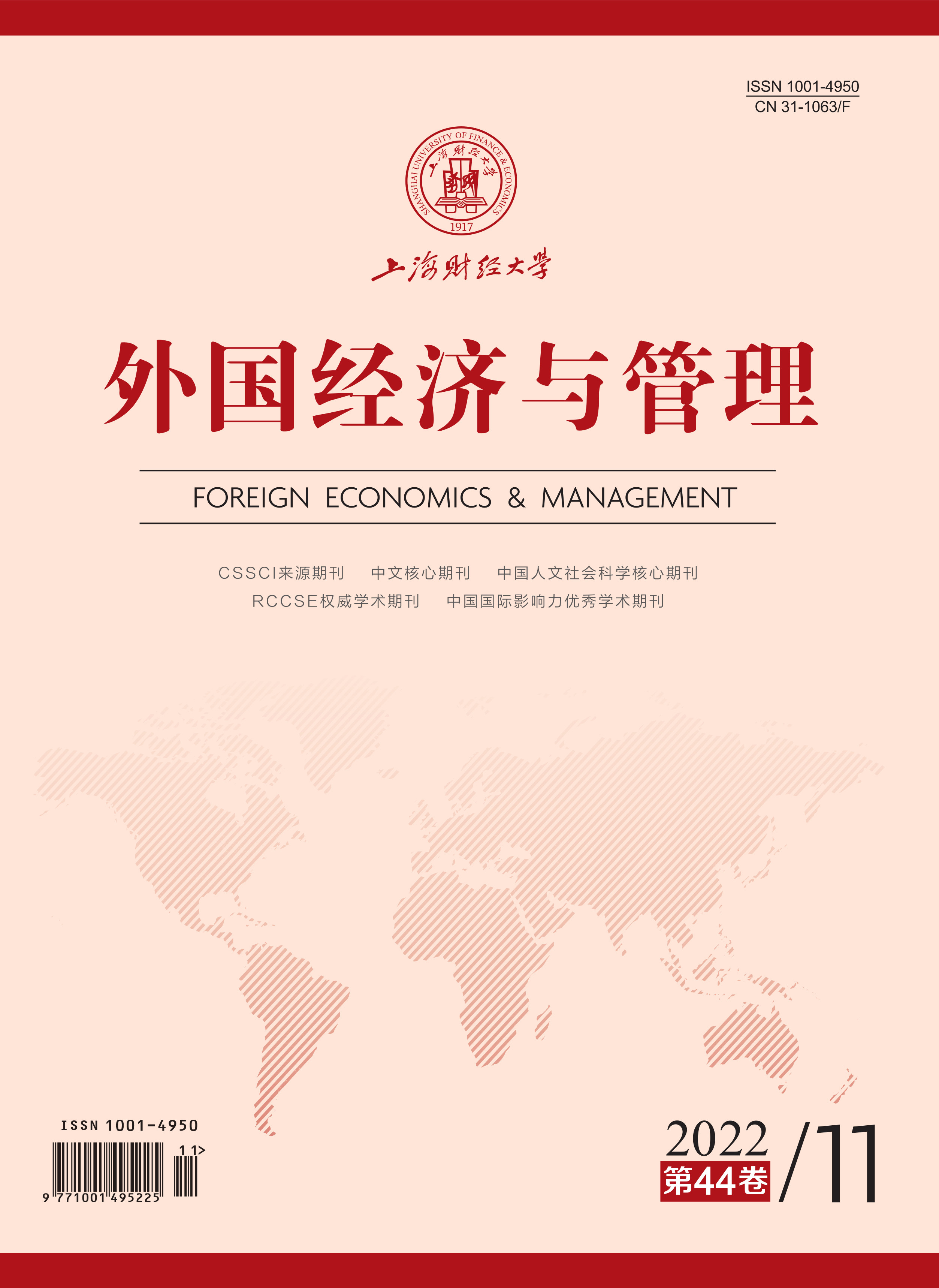[1] Chen Zhibin, Wang Guanzhen. CEO Discretion and Enterprise Investment Efficiency[J]. Accounting Research, 2020(12):85-98.
[2] Dong Jing, Zhao Guozhen, Chen Wenfeng. Will the involvement of venture capital affect entrepreneurial firms’ business model? [J]. Foreign Economics & Management,2021, 43(4): 64-84.
[3] Li Jun et al. Study on the Influence of Managerial Ability on Enterprises' Innovation Performance:The Moderating Effect of Nature of Property Right and Product Market Competition[J]. East China Economic Management, 2020,34(06):47-55.
[4] Li Mei, Gao Shanxing. Research on Relationships between Environmental Uncertainty, Organizational Slack and Original Innovation[J]. Management Review, 2014,26(01):47-56.
[5] Liu Jianmin et al. Government Subsidy, Management Power and State-owned Executives' Excess Remuneration[J]. Accounting Research,2019(08):64-70.
[6] Shi Huibin & Yang Dong. The Impact of the Configuration of CEO Power on Innovation Ambidexterity[J]. Soft Science, 2017,31(11):49-51+61.
[7] Wu Xiaojie et al. The Literature Review of Principal-Agent Theory in Chinese Management Research Based on A Multi-Level Context-Embedded Analysis Framework[J]. Chinese Journal of Management, 2017,14(06):936-946.
[8] Xie Peihong, Wang Chunxia. Managerial Power, Corporation Lifecycle and Investment Efficiency: Empirical Research Based on Chinese Manufacturing Listed Companies[J]. Nankai Business Review, 2017,20(01):57-66.
[9] Yao Lijie & Zhou Ying. Managerial Ability,Innovation Ability and Innovation Efficiency[J]. Accounting Research, 2018(06):70-77.
[10] Yun Jiang, Ning Xin. “Young and Promsing Young” or “Old but Vigorous”: CEO Career Concerns and Strategic Change[J]. Business and Management Journal, 2020,42(06):135-152.
[11] Baik B, Farber D B, Lee S. CEO ability and management earnings forecasts[J]. Contemporary Accounting Research,2011, 28(5): 1645-1668.
[12] Benner M J, Tushman M. Process management and technological innovation: A longitudinal study of the photography and paint industries[J]. Administrative Science Quarterly,2002, 47(3): 676-707.
[13] Boone C, Van Olffen W, Van Witteloostuijn A, et al. The genesis of top management team diversity: Selective turnover among top management teams in Dutch newspaper publishing, 1970-94[J]. Academy of Management Journal,2004, 47(5): 633-656.
[14] Buyl T, Boone C, Hendriks W, et al. Top management team functional diversity and firm performance: The moderating role of CEO characteristics[J]. Journal of Management Studies,2011, 48(1): 151-177.
[15] Cao Q, Gedajlovic E, Zhang H P. Unpacking organizational ambidexterity: Dimensions, contingencies, and synergistic effects[J]. Organization Science,2009, 20(4): 781-796.
[16] Chemmanur T J, Hu G, Huang J K. The role of institutional investors in initial public offerings[J]. The Review of Financial Studies,2010, 23(12): 4496-4540.
[17] Chen G L, Crossland C, Luo S Q. Making the same mistake all over again: CEO overconfidence and corporate resistance to corrective feedback[J]. Strategic Management Journal,2015, 36(10): 1513-1535.
[18] Cho C, Halford J T, Hsu S, et al. Do managers matter for corporate innovation?[J]. Journal of Corporate Finance,2016, 36: 206-229.
[19] Crossland C, Hambrick D C. How national systems differ in their constraints on corporate executives: A study of CEO effects in three countries[J]. Strategic Management Journal,2007, 28(8): 767-789.
[20] Demerjian P, Lev B, McVay S. Quantifying managerial ability: A new measure and validity tests[J]. Management Science,2012, 58(7): 1229-1248.
[21] Finkelstein S. Power in top management teams: Dimensions, measurement, and validation[J]. Academy of Management Journal,1992, 35(3): 505-538.
[22] Ghosh D, Olsen L. Environmental uncertainty and managers' use of discretionary accruals[J]. Accounting, Organizations and Society,2009, 34(2): 188-205.
[23] Hambrick D C. Upper echelons theory: An update[J]. Academy of Management Review,2007, 32(2): 334-343.
[24] Hambrick D C, Cho T S, Chen M J. The influence of top management team heterogeneity on Firms' competitive moves[J]. Administrative Science Quarterly,1996, 41(4): 659-684.
[25] Hambrick D C, Mason P A. Upper echelons: The organization as a reflection of its top managers[J]. Academy of Management Review,1984, 9(2): 193-206.
[26] Harrison D A, Klein K J. What's the difference? Diversity constructs as separation, variety, or disparity in organizations[J]. Academy of Management Review,2007, 32(4): 1199-1228.
[27] Hirshleifer D, Low A, Teoh S H. Are overconfident CEOs better innovators?[J]. Journal of Finance,2012, 67(4): 1457-1498.
[28] Holcomb T R, Holmes Jr R M, Connelly B L. Making the most of what you have: Managerial ability as a source of resource value creation[J]. Strategic Management Journal,2009, 30(5): 457-485.
[29] Li J T, Tang Y. CEO hubris and firm risk taking in China: The moderating role of managerial discretion[J]. Academy of Management Journal,2010, 53(1): 45-68.
[30] Lin C, Chang C C. A Patent-based study of the relationships among technological portfolio, ambidextrous innovation, and firm performance[J]. Technology Analysis & Strategic Management,2015, 27(10): 1193-1211.
[31] Lin H E, McDonough III E F. Cognitive frames, learning mechanisms, and innovation ambidexterity[J]. Journal of Product Innovation Management,2014, 31(S1): 170-188.
[32] March J G. Exploration and exploitation in organizational learning[J]. Organization Science,1991, 2(1): 71-87.
[33] Ndofor H A, Sirmon D G, He X M. Utilizing the firm's resources: How TMT heterogeneity and resulting faultlines affect TMT tasks[J]. Strategic Management Journal,2015, 36(11): 1656-1674.
[34] Reagans R, Zuckerman E W. Networks, diversity, and productivity: The social capital of corporate R&D teams[J]. Organization Science,2001, 12(4): 502-517.
[35] Sirmon D G, Hitt M A, Ireland R D. Managing firm resources in dynamic environments to create value: Looking inside the black box[J]. Academy of Management Review,2007, 32(1): 273-292.
[36] Stewart G L, Barrick M R. Team structure and performance: Assessing the mediating role of intrateam process and the moderating role of task type[J]. Academy of Management Journal,2000, 43(2): 135-148.
[37] Tett R P, Burnett D D. A personality trait-based interactionist model of job performance[J]. Journal of Applied Psychology,2003, 88(3): 500-517.
[38] Tett R P, Simonet D V, Walser B, et al. Trait activation theory: Applications, developments, and implications for person-workplace fit[A]. Christiansen N D, Tett R P. Handbook of personality at work[M]. New York: Routledge, 2013: 71-100.
[39] Uotila J, Maula M, Keil T, et al. Exploration, exploitation, and financial performance: Analysis of S&P 500 corporations[J]. Strategic Management Journal,2009, 30(2): 221-231.
[40] Wei Z L, Yi Y Q, Guo H. Organizational learning ambidexterity, strategic flexibility, and new product development[J]. Journal of Product Innovation Management,2014, 31(4): 832-847.
[41] Yung K, Chen C. Managerial ability and firm risk-taking behavior[J]. Review of Quantitative Finance and Accounting,2018, 51(4): 1005-1032.





 8186
8186  7866
7866

